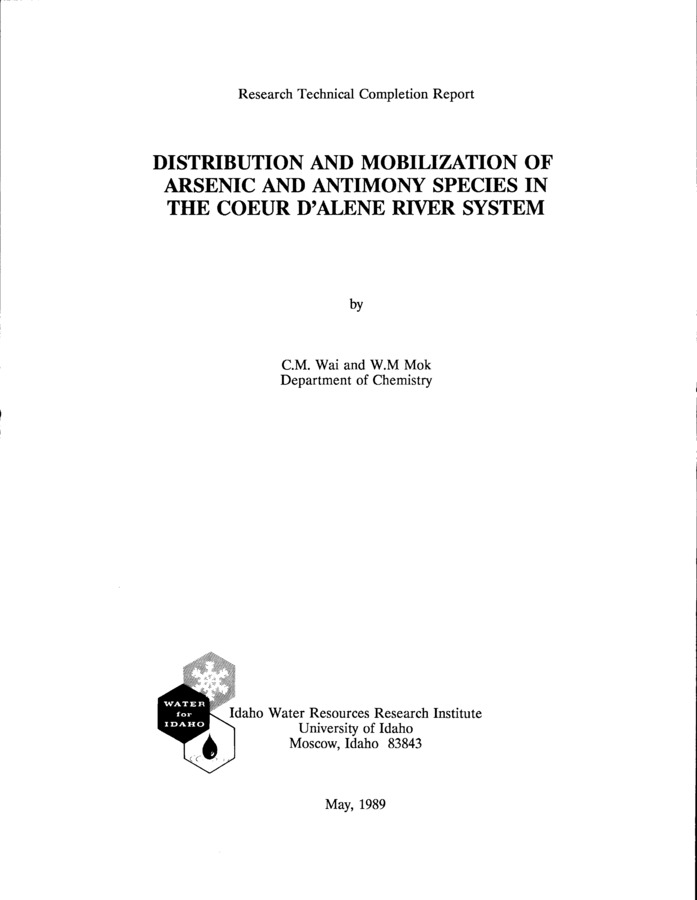PDF
Distribution and mobilization of arsenic and antimony species in the Coeur d'Alene River system. Research technical completion report, 14-08-0001-G1222-07 Item Info
- Title:
- Distribution and mobilization of arsenic and antimony species in the Coeur d'Alene River system. Research technical completion report, 14-08-0001-G1222-07
- Authors:
- Wai, C. M.; Mok, W. M.
- Contributors:
- Idaho Water Resources Research Institute; IWRRI
- Date:
- 1989-05
- Description:
- The mining industry along the South Fork of the Coeur d'Alene River in northern Idaho is a major producer of silver, lead, and zinc in the United States. Mining operations in the past have discharged huge amounts of mining wastes into the South Fork of the river causing a serious pollution problem for the Coeur d'Alene River system. Sediments in the South Fork and the Main Stem of the river are contaminated with arsenic(As), antimony(Sb), cadmium(Cd), Lead(Pb), Zinc(Zn), and other metals. The North Fork water was found relatively uncontaminated and showed very low concentrations of As ( <0.26 ng/mL) and Sb ( <0.17 ng/mL). Water samples collected from the South Fork showed high levels of As (0.16-1.64 ng/mL) and Sb (1.11-8.25 ng/mL). Relatively lower concentrations of As (0.11-1.48 ng/mL) and Sb (0.23-1.90 ng/mL) were found in the main stem of the river. Arsenic(lll) was the predominant form of As in the South Fork and main stem, whereas the North Fork generally had a higher As(V) concentration in water. Antimony(V) was the major Sb species in the three branches of the river. Leaching of As and Sb from the sediments along the main stem depends on the pH of the water and on the iron and manganese content of the sediments. The amount of As and Sb leached was high in acidic or in basic solutions. The enhanced desorption of As and Sb in basic solutions was probably related to the anionic properties of these elements. An accumulation of As and Sb on the surface sediments was also observed in the delta area where the river enters Lake Coeur d'Alene. The releases of As and Sb from the sediments appear to associate with the free iron oxides and manganese oxides in the sediments. The leaching characteristics of Sb are similar to those of As. However, releases of sediment Sb were generally found linear with respect to time while asymptotic limits on As releases were reached. Significant amounts of Zn, Fe, and Mn were also released during leaching, but Cu, Cd, Ph, and Ni were much less leachable. According to this study, interaction of water with the existing sediments is likely to be a major factor controlling the water quality of the Coeur d'Alene River.
- Subjects:
- mining wastes water pollution arsenic speciation sediments antimony
- Location:
- Coeur d'Alene River
- Idaho County:
- Shoshone County
- Latitude:
- 47.51
- Longitude:
- -116.15
- Collection:
- Coeur d'Alene Basin
- Series:
- Water for Idaho
- Source:
- Idaho Water Resources Research Institute, University of Idaho
- Identifier:
- IWRRI Number 198906
- Publisher:
- Idaho Water Resources Research Institute, University of Idaho
- Contributing Institution:
- University of Idaho
- Type:
- Text
- Format:
- application/pdf
- Cataloger:
- wbv
- Date Digitized:
- 2012
- Language:
- eng
Source
- Preferred Citation:
- "Distribution and mobilization of arsenic and antimony species in the Coeur d'Alene River system. Research technical completion report, 14-08-0001-G1222-07", Idaho Waters Digital Library, University of Idaho Library Digital Collections, https://www.lib.uidaho.edu/digital/iwdl/items/iwdl-cda_wai_1989.html
Rights
- Rights:
- In copyright, educational use permitted. Educational use includes non-commercial reproduction of text and images in materials for teaching and research purposes. For other contexts beyond fair use, including digital reproduction, please contact the University of Idaho Library Special Collections and Archives Department at libspec@uidaho.edu. The University of Idaho Library is not liable for any violations of the law by users.
- Standardized Rights:
- http://rightsstatements.org/vocab/InC-EDU/1.0/

